CFE said:
But there were plenty of innovative features in the McDD concept. I'd expect it to be more maneuverable based on its decelerons + Pelikan tails for yaw control. The lambda wing probably was stealthier from the aft view than either the LockMart or Boeing competitors. Perhaps this all added up to a plane that was too expensive. But truth be told, there's so much I don't know about the design's weaknesses and strengths.
according to this video, the almost tailless aircraft is so unstable that it is also aided by a multi axis thrust vectoring nozzle. This would be the first of its kind, because no other aircraft has ever used TVC as part of the fly-by-wire system to keep the plane stable. It was too risky that the DoD cut it off. A Lockheed person later recalled that anyone could design a plane on paper, but only lockheed has the experience to put the whole package together, avionics, integration, etc or something like that.
http://www.youtube.com/watch?v=qbZ2Q6lStJE
Concerning the STOVL approach, McDonald Douglas chose it because it offer a plane that is lean and sleak, which directly translate into better raw powers (agility, speed, acceleration, etc.) I wouldn't be surprised if the McDD design was the only that could achieve mach 2+ instead of the 1.6-1.8+ based line, consider how sleek it is and its wing sweep angle.
Concerning the wing, I'm not sure about stealthier, I believe that it offered better agility rather than stealth, because it offer more "spikes" radar returns than say.... a diamond wing. To my understanding, it would also be structural heavier and complex wing than the other proposals though, according to this slide on the choice of lambda wing for FATE project.
http://www.fas.org/man/dod-101/sys/ac/docs/fatereport/sld035.htm
All in all, I think what Aboulafia meant is that McDD proposal is too risky for a low cost fighter to gain advantages in area that, though desireable, weren't priorities, such as better raw performance (speed and agility was only required to match legacy aircraft, with avionics more emphasized) and stealthier (low end fighter, adequate stealth was enough). If we look at the other designs, we see that they too take risk, but for advantages that the DoD greatly sought after. The boeing's was the riskiest of all 3, but the risk was to offer a very low cost production aircraft with enormous fuel. The lockheed approach of STOVL was risky, but what it offered was what marines mostly sought.






